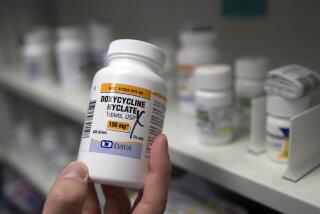Drug Users and AIDS
At least one important proposal has emerged from the Presidential Commission on AIDS in its first interim report. Citing the continued and apparently accelerated spread of the disease among intravenous drug users, the commission called attention to the desperate need for additional drug-treatment centers, the single most effective place where the spread might be curtailed.
If the commission succeeds in prying more federal funds for the drug program from President Reagan, it will have justified its establishment. Until now, the President has preferred advocating drug-education programs that encourage young people simply to say “no,” but even these programs are underfunded. And they have had no apparent effect on committed abusers.
Retired Adm. James D. Watkins, who has been working with some success to set the commission on a constructive course since he took over as chairman in mid-November, made the interim report. One of the most reassuring elements of his report was his statement that the commission would not shy away from controversial issues, nor will it be bound to seeking unanimity. Several of the members have already demonstrated the validity of doubts raised when the President chose them. But the majority have shown a determination to keep them from diverting the commission from its principal role.
As if to demonstrate the willingness of the commission to look at controversial issues, Watkins said that the commission now has under consideration a proposal to make sterile needles available to intravenous drug users as a way of stemming the spread of AIDS through used needles. This has been tried in a number of places, with mixed results.
Watkins also called for faster approval of experimental drugs. His appeal appeared to be based on anecdotal information, including the wish of an AIDS-infected commission staff member to obtain a drug that is now on trial in France but not yet approved for experimental use in the United States. The recommendation did not appear to be supported by adequate evidence. Some of the most respected public-health officials with whom we have talked are convinced that the U.S. government is moving with appropriate speed in approving drugs for testing. The consequences of accelerating this process have already been demonstrated by the recall of one experimental drug that had disastrous side effects, worsening the condition of patients.
Implicit in the first report of the commission is the need for more adequate resources, including additional funds for drug rehabilitation. The spread of AIDS in the intravenous drug community in California is, so far, mercifully low, with indications that no more than 5% are infected thus far. But in New York and New Jersey there are drug groups with as many as 80% infected. That obviously could happen throughout the nation unless steps are taken to mount education and rehabilitation programs that modify the high-risk behavior of these persons.
The extent of the threat was again emphasized in a new report from the Centers for Disease Control, reaffirming an earlier estimate that 1 million to 1.5 million Americans carry the AIDS virus. About 47,000 actual cases of AIDS have been counted in the United States; 60% have died. Dr. Otis R. Bowen, secretary of health and human services, cautioned once again against “panic,” noting that there is “not a wildly spreading epidemic among heterosexuals.” But containment remains dependent on individual behavior. The spread among homosexuals, who account for most cases in the United States, has almost come to a halt because of the widespread acceptance in that community of behavior changes, including the use of condoms and the curtailment of free-wheeling sex. But a single exposure can bring infection with the virus and the likelihood of developing the disease, which is still without a known cure.
More to Read
Sign up for Essential California
The most important California stories and recommendations in your inbox every morning.
You may occasionally receive promotional content from the Los Angeles Times.










